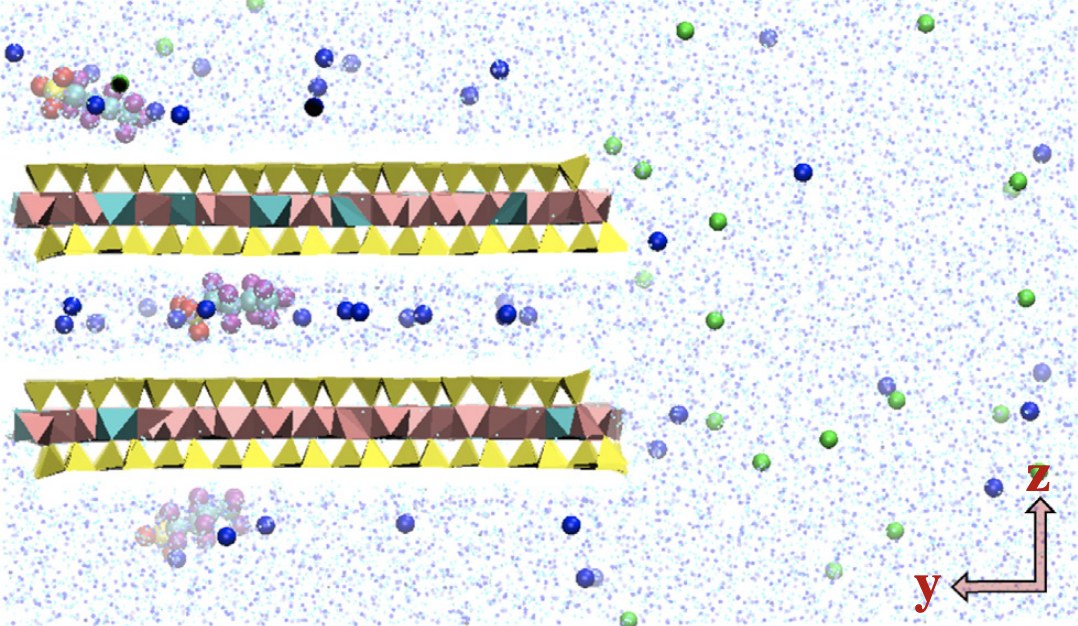Environmentalist Rachel Carson’s famous book Silent Spring (1962) first brought public attention to organic contaminants such as DDT, a common insecticide that caused detrimental impacts to numerous ecosystems until its EPA cancellation order in 1972. Organic contaminants are a wide class of carbon-containing chemicals, encompassing familiar names such as glyphosate (RoundUp) and BPAs. They are created and discarded by human industry and are often transported into ecosystems through runoff water. To get a better understanding of modern research involving these contaminants, I interviewed Ian Bourg, Assistant Professor of Civil and Environmental Engineering and the High Meadows Environmental Institute. Professor Bourg leads the Interfacial Water Group at Princeton, which focuses on understanding the microscopic processes which occur when water is in contact with air, clay, and organic contaminants.

Image Credit: Ian Bourg via https://cee.princeton.edu/people/ian-bourg
Why do you study processes at the microscopic scale?
Mostly what we’re doing is trying to understand the fundamental properties of matter, focusing on systems that are relevant to the environment – either in the natural environment or in engineered systems that are being used for protecting the environment. When a typical engineering group is doing work, they’re trying to design ways to manipulate the world and on the human scale to reach certain desired outcomes. Because many engineers work on the macroscopic scale, they use equations that represent the world at the macroscopic scale. In a lot of cases, we think that we can improve these equations if we gain more fundamental insight into how matter behaves at smaller scales.
Could you give a brief overview of your current research? What makes it interesting to you?
I’m interested in water in general because water is cool and water is important. Most water on the surface of the earth, or model that people are familiar with, is […] bulk liquid water, so like water in the ocean or in a glass. The properties of bulk liquid water are pretty well understood by now. Water near a surface remains kind of not that well understood, right? [For example] if I look at water near the water-air interface or near a solid surface or something like that, it changes its properties in various interesting ways depending on what’s on the other side of the interface.
The reason why we study clay is coming from our interest in water at interfaces, in that […] if you look at the average chemistry of the Earth’s crust, it’s mostly oxygen, silicon, and aluminum. There’s one way of packing together oxygen, silicon, and aluminum inside a crystalline structure that is apparently extremely stable and pretty close to the composition of the crust. That clay structure is a kind of structural motif that makes up half of the sedimentary rock mass, half of the mineral mass in soils, and about a third of the rock mass of the surface. If we’re interested in the interfaces between water and a mineral, most of it near the surface of the Earth would be water in contact with those specific minerals. So just kind of like by sheer abundance, if we’re interested in mineral-water interfaces, [clay] is the most logical one to be looking at.

Simulated clay-water interface with organic contaminant PFBS and calcium chloride ions.
Image Credit: Jennifer Willemsen and Ian Bourg via Molecular dynamics simulation of the adsorption of per-and polyfluoroalkyl substances (PFASs) on smectite clay, Journal of Colloid and Interface Science, 2021
What are some common obstacles in removing or remediating contaminants in our natural systems?
My Ph.D. advisor always used to say that science doesn’t solve problems, it just replaces one problem with a different problem. It kind of seems a little bit bleak, […] but then, on the other hand, you’re just basically hoping that you’re replacing a big problem with a smaller problem, right? Organic contaminants that are present in natural systems tend to decay naturally with some kind of exponential decay, both through interaction with sunlight, like if they’re in a river or lake and also by being accidentally broken down by microorganisms. There’s some trickiness with that in that it often generates collections of byproducts or degradation products, that in some cases can actually be more toxic than the initial contaminant. A lot of engineered processes for removing contaminants from a system basically just remove them by transferring them to a different system. It doesn’t take [the contaminant] out of the system completely, so it’s always going to be there. Historically a lot of environmental engineering has kind of focused on protecting humans, basically preventing contaminants from coming into contact with humans, whereas a more sustainable approach would be actually removing contamination from the Earth.
What does sustainability mean to you?
I think sustainability to me means thinking about the entire lifecycle of some kind of environmental issue, I guess it’s easier for me to think of in terms of contaminants or carbon. I feel like sustainability kind of in a way also forces you to think more about natural processes. We try to focus on what we think are the most pressing kind of environmental concerns that humanity is facing, and often those happen to be concerns where [the] most pressing environmental issues are the ones where humans are clearly behaving in a very unsustainable way.
Are there any sustainability or climate science resources you know of that you would suggest for readers?
I did read Silent Spring six months ago and I was like this book is amazing! I don’t know why I didn’t read it before, you know. It’s also scary, but interesting.

Image Credit: National Museum of American History via https://americanhistory.si.edu/collections/search/object/nmah_1453548
One thing that I try to do in in CEE 207, the Intro to Environmental Engineering course, is to take a 10-minute break and talk about environmental news in like the major news outlets that that came out since the previous lecture. The Guardian has had a ton of really nice kind of environmental coverage for the last several years.

This is such a great intro to the big ideas (about smallness!) behind the Interfacial Water Group’s work. I haven’t read Silent Spring yet, but Prof. Bourg’s recommendation moves it up on my to-read list.